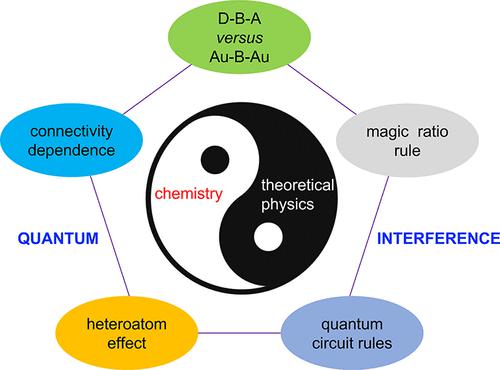当前位置:
X-MOL 学术
›
Acc. Chem. Res.
›
论文详情
Our official English website, www.x-mol.net, welcomes your
feedback! (Note: you will need to create a separate account there.)
Signatures of Room-Temperature Quantum Interference in Molecular Junctions
Accounts of Chemical Research ( IF 16.4 ) Pub Date : 2023-01-24 , DOI: 10.1021/acs.accounts.2c00726 Shi-Xia Liu 1 , Ali K Ismael 2, 3 , Alaa Al-Jobory 2, 4 , Colin J Lambert 2
Accounts of Chemical Research ( IF 16.4 ) Pub Date : 2023-01-24 , DOI: 10.1021/acs.accounts.2c00726 Shi-Xia Liu 1 , Ali K Ismael 2, 3 , Alaa Al-Jobory 2, 4 , Colin J Lambert 2
Affiliation

|
During the past decade or so, research groups around the globe have sought to answer the question: “How does electricity flow through single molecules?” In seeking the answer to this question, a series of joint theory and experimental studies have demonstrated that electrons passing through single-molecule junctions exhibit exquisite quantum interference (QI) effects, which have no classical analogues in conventional circuits. These signatures of QI appear even at room temperature and can be described by simple quantum circuit rules and a rather intuitive magic ratio theory. The latter describes the effect of varying the connectivity of electrodes to a molecular core and how electrical conductance can be controlled by the addition of heteroatoms to molecular cores. The former describes how individual moieties contribute to the overall conductance of a molecule and how the overall conductance can change when the connectivities between different moieties are varied. Related circuit rules have been derived and demonstrated, which describe the effects of connectivity on Seebeck coefficients of organic molecules. This simplicity arises because when a molecule is placed between two electrodes, charge transfer between the molecule and electrodes causes the molecular energy levels to adjust, such that the Fermi energy (EF) of the electrodes lies within the energy gap between the highest occupied molecular orbital and lowest unoccupied molecular orbital. Consequently, when electrons of energy EF pass through a molecule, their phase is protected and transport takes place via phase-coherent tunneling. Remarkably, these effects have been scaled up to self-assembled monolayers of molecules, thereby creating two-dimensional materials, whose room temperature transport properties are controlled by QI. This leads to new molecular design strategies for increasing the on/off conductance ratio of molecular switches and to improving the performance of organic thermoelectric materials. In particular, destructive quantum interference has been shown to improve the Seebeck coefficient of organic molecules and increase their on/off ratio under the influence of electrochemical gating. The aim of this Account is to introduce the novice reader to these signatures of QI in molecules, many of which have been identified in joint studies involving our theory group in Lancaster University and experimental group in Bern University.
中文翻译:

分子连接中室温量子干涉的特征
在过去十年左右的时间里,全球的研究小组一直在试图回答这个问题:“电流是如何流过单分子的?” 在寻找这个问题的答案时,一系列联合理论和实验研究表明,通过单分子结的电子表现出精致的量子干涉 (QI) 效应,这在传统电路中没有经典的类似物。QI 的这些特征甚至在室温下也会出现,并且可以用简单的量子电路规则和相当直观的魔比理论来描述。后者描述了改变电极与分子核的连接性的影响,以及如何通过向分子核中添加杂原子来控制电导率。前者描述了单个部分如何影响分子的整体电导,以及当不同部分之间的连接性发生变化时整体电导如何变化。相关的电路规则已经推导和证明,它描述了连通性对有机分子塞贝克系数的影响。这种简单性的出现是因为当一个分子被放置在两个电极之间时,分子和电极之间的电荷转移导致分子能级调整,使得费米能量(电极的E F ) 位于最高占据分子轨道和最低未占据分子轨道之间的能隙内。因此,当能量为E F的电子通过一个分子,它们的相位受到保护,传输通过相位相干隧道发生。值得注意的是,这些效应已经扩大到分子的自组装单层,从而产生二维材料,其室温传输特性由 QI 控制。这导致了新的分子设计策略,用于增加分子开关的开/关电导比并改善有机热电材料的性能。特别是,破坏性量子干涉已被证明可以提高有机分子的塞贝克系数,并在电化学门控的影响下增加它们的开/关比。这个帐户的目的是向新手读者介绍分子中 QI 的这些特征,
更新日期:2023-01-24
中文翻译:

分子连接中室温量子干涉的特征
在过去十年左右的时间里,全球的研究小组一直在试图回答这个问题:“电流是如何流过单分子的?” 在寻找这个问题的答案时,一系列联合理论和实验研究表明,通过单分子结的电子表现出精致的量子干涉 (QI) 效应,这在传统电路中没有经典的类似物。QI 的这些特征甚至在室温下也会出现,并且可以用简单的量子电路规则和相当直观的魔比理论来描述。后者描述了改变电极与分子核的连接性的影响,以及如何通过向分子核中添加杂原子来控制电导率。前者描述了单个部分如何影响分子的整体电导,以及当不同部分之间的连接性发生变化时整体电导如何变化。相关的电路规则已经推导和证明,它描述了连通性对有机分子塞贝克系数的影响。这种简单性的出现是因为当一个分子被放置在两个电极之间时,分子和电极之间的电荷转移导致分子能级调整,使得费米能量(电极的E F ) 位于最高占据分子轨道和最低未占据分子轨道之间的能隙内。因此,当能量为E F的电子通过一个分子,它们的相位受到保护,传输通过相位相干隧道发生。值得注意的是,这些效应已经扩大到分子的自组装单层,从而产生二维材料,其室温传输特性由 QI 控制。这导致了新的分子设计策略,用于增加分子开关的开/关电导比并改善有机热电材料的性能。特别是,破坏性量子干涉已被证明可以提高有机分子的塞贝克系数,并在电化学门控的影响下增加它们的开/关比。这个帐户的目的是向新手读者介绍分子中 QI 的这些特征,











































 京公网安备 11010802027423号
京公网安备 11010802027423号